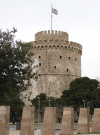
White Tower from 12th century. (960k)
From the Thessaloniki entry in Wikipedia:
The city was founded in 315 BCE by Cassander of Macedon, who named it after his wife Thessalonike, daughter of Philip II of Macedon and sister of Alexander the Great. An important metropolis by the Roman period, Thessaloniki was the second largest and wealthiest city of the Byzantine Empire. It was conquered by the Ottomans in 1430 and remained an important seaport and multi-ethnic metropolis during the nearly five centuries of Turkish rule. It passed from the Ottoman Empire to the Kingdom of Greece on 8 November 1912. Thessaloniki exhibits Byzantine architecture, including numerous Paleochristian and Byzantine monuments, a World Heritage Site, as well as several Roman, Ottoman and Sephardic Jewish structures.
The city was founded around 315 BCE by the King Cassander of Macedon, on or near the site of the ancient town of Therma and 26 other local villages. He named it after his wife Thessalonike, a half-sister of Alexander the Great and princess of Macedonia as daughter of Philip II. Under the kingdom of Macedonia the city retained its own autonomy and parliament and evolved to become the most important city in Macedonia.
After the fall of the Kingdom of Macedonia in 168 BCE, in 148 BCE Thessalonica was made the capital of the Roman province of Macedonia. Thessalonica became a free city of the Roman Republic under Mark Antony in 41 BCE. It grew to be an important trade hub located on the Via Egnatia, the road connecting Dyrrhachium with Byzantium, which facilitated trade between Thessaloniki and great centers of commerce such as Rome and Byzantium. Thessaloniki also lays at the southern end of the main north–south route through the Balkans along the valleys of the Morava and Axios river valleys, thereby linking the Balkans with the rest of Greece. The city became the capital of one of the four Roman districts of Macedonia.
At the time of the Roman Empire, about 50 A.D., Thessaloniki was also one of the early centers of Christianity; while on his second missionary journey, Paul the Apostle visited this city's chief synagogue on three Sabbaths and sowed the seeds for Thessaloniki's first Christian church. Later, Paul wrote letters to the new church at Thessaloniki, with two letters to the church under his name appearing in the Biblical canon as First and Second Thessalonians. Some scholars hold that the First Epistle to the Thessalonians is the first written book of the New Testament.
In 306 CE, Thessaloniki acquired a patron saint, St. Demetrius, a Christian whom Galerius is said to have put to death. Most scholars agree with Hippolyte Delehaye's theory that Demetrius was not a Thessaloniki native, but his veneration was transferred to Thessaloniki when it replaced Sirmium as the main military base in the Balkans. A basilical church dedicated to St. Demetrius, Hagios Demetrios, was first built in the fifth century CE and is now a UNESCO World Heritage Site.
When the Roman Empire was divided into the tetrarchy, Thessaloniki became the administrative capital of one of the four portions of the Empire under Galerius Maximianus Caesar, where Galerius commissioned an imperial palace, a new hippodrome, a triumphal arch and a mausoleum among others.
In 379, when the Roman Prefecture of Illyricum was divided between the East and West Roman Empires, Thessaloniki became the capital of the new Prefecture of Illyricum. The following year, the Edict of Thessalonica made Christianity the state religion of the Roman Empire. In 390, Gothic troops under the Roman Emperor Theodosius I, led a massacre against the inhabitants of Thessalonica, who had risen in revolt against the Gothic soldiers. By the time of the Fall of Rome in 476, Thessaloniki was the second-largest city of the Eastern Roman Empire.
From the first years of the Byzantine Empire, Thessaloniki was considered the second city in the Empire after Constantinople, both in terms of wealth and size. with a population of 150,000 in the mid-12th century. The city held this status until its transfer to Venetian control in 1423. In the 14th century, the city's population exceeded 100,000 to 150,000, making it larger than London at the time.
During the sixth and seventh centuries, the area around Thessaloniki was invaded by Avars and Slavs, who unsuccessfully laid siege to the city several times, as narrated in the Miracles of Saint Demetrius. Traditional historiography stipulates that many Slavs settled in the hinterland of Thessaloniki; however, modern scholars consider this migration to have been on a much smaller scale than previously thought. In the ninth century, the Byzantine missionaries Cyril and Methodius, both natives of the city, created the first literary language of the Slavs, the Old Church Slavonic, most likely based on the Slavic dialect used in the hinterland of their hometown.
A naval attack led by Byzantine converts to Islam (including Leo of Tripoli) in 904 resulted in the sack of the city.
The economic expansion of the city continued through the 12th century as the rule of the Komnenoi emperors expanded Byzantine control to the north. Thessaloniki passed out of Byzantine hands in 1204, when Constantinople was captured by the forces of the Fourth Crusade and incorporated the city and its surrounding territories in the Kingdom of Thessalonica — which then became the largest vassal of the Latin Empire. In 1224, the Kingdom of Thessalonica was overrun by the Despotate of Epirus, a remnant of the former Byzantine Empire, under Theodore Komnenos Doukas who crowned himself Emperor, and the city became the capital of the short-lived Empire of Thessalonica. Following his defeat at Klokotnitsa however in 1230, the Empire of Thessalonica became a vassal state of the Second Bulgarian Empire until it was recovered again in 1246, this time by the Nicaean Empire.
In 1342, the city saw the rise of the Commune of the Zealots, an anti-aristocratic party formed of sailors and the poor, which is nowadays described as social-revolutionary. The city was practically independent of the rest of the Empire, as it had its own government, a form of republic. The zealot movement was overthrown in 1350 and the city was reunited with the rest of the Empire.
The capture of Gallipoli by the Ottomans in 1354 kicked off a rapid Turkish expansion in the southern Balkans, conducted both by the Ottomans themselves and by semi-independent Turkish ghazi warrior-bands. By 1369, the Ottomans were able to conquer Adrianople (modern Edirne), which became their new capital until 1453. Thessalonica, ruled by Manuel II Palaiologos (r. 1391–1425) itself surrendered after a lengthy siege in 1383–1387, along with most of eastern and central Macedonia, to the forces of Sultan Murad I. Initially, the surrendered cities were allowed complete autonomy in exchange for payment of the kharaj poll-tax. Following the death of Emperor John V Palaiologos in 1391, however, Manuel II escaped Ottoman custody and went to Constantinople, where he was crowned emperor, succeeding his father. This angered Sultan Bayezid I, who laid waste to the remaining Byzantine territories, and then turned on Chrysopolis, which was captured by storm and largely destroyed. Thessalonica too submitted again to Ottoman rule at this time, possibly after brief resistance, but was treated more leniently: although the city was brought under full Ottoman control, the Christian population and the Church retained most of their possessions, and the city retained its institutions. Thessalonica remained in Ottoman hands until 1403, when Emperor Manuel II sided with Bayezid's eldest son Süleyman in the Ottoman succession struggle that broke out following the crushing defeat and capture of Bayezid at the Battle of Ankara against Tamerlane in 1402. In exchange for his support, in the Treaty of Gallipoli the Byzantine emperor secured the return of Thessalonica, part of its hinterland, the Chalcidice peninsula, and the coastal region between the rivers Strymon and Pineios. Thessalonica and the surrounding region were given as an autonomous appanage to John VII Palaiologos. After his death in 1408, he was succeeded by Manuel's third son, the Despot Andronikos Palaiologos, who was supervised by Demetrios Leontares until 1415. Thessalonica enjoyed a period of relative peace and prosperity after 1403, as the Turks were preoccupied with their own civil war, but was attacked by the rival Ottoman pretenders in 1412 (by Musa Çelebi) and 1416 (during the uprising of Mustafa Çelebi against Mehmed I). Once the Ottoman civil war ended, the Turkish pressure on the city began to increase again. Just as during the 1383–1387 siege, this led to a sharp division of opinion within the city between factions supporting resistance, if necessary with Western help, or submission to the Ottomans.
In 1423, Despot Andronikos Palaiologos ceded it to the Republic of Venice with the hope that it could be protected from the Ottomans who were besieging the city. The Venetians held Thessaloniki until it was captured by the Ottoman Sultan Murad II on 29 March 1430.
When Sultan Murad II captured Thessaloniki and sacked it in 1430, contemporary reports estimated that about one-fifth of the city's population was enslaved. Ottoman artillery was used to secure the city's capture and bypass its double walls. Upon the conquest of Thessaloniki, some of its inhabitants escaped, including intellectuals such as Theodorus Gaza "Thessalonicensis" and Andronicus Callistus. However, the change of sovereignty from the Byzantine Empire to the Ottoman one did not affect the city's prestige as a major imperial city and trading hub. Thessaloniki and Smyrna, although smaller in size than Constantinople, were the Ottoman Empire's most important trading hubs. Thessaloniki's importance was mostly in the field of shipping, but also in manufacturing, while most of the city's trade was controlled by Jewish.
During the Ottoman period, the city's population of Ottoman Muslims (including those of Turkish origin, as well as Albanian Muslim, Bulgarian Muslim and Greek Muslim of convert origin) grew substantially. According to the 1478 census Selânik (Ottoman Turkish: سلانیك), as the city came to be known in Ottoman Turkish, had 6,094 Christian Orthodox households, 4,320 Muslim ones, and some Catholic. No Jews were recorded in the census suggesting that the subsequent influx of Jewish population was not linked to the already existing Romaniots community. Soon after the turn of the 15th to 16th century, however, nearly 20,000 Sephardic Jews immigrated to Greece from the Iberian Peninsula following their expulsion from Spain by the 1492 Alhambra Decree. By c. 1500, the number of households had grown to 7,986 Christian ones, 8,575 Muslim ones, and 3,770 Jewish. By 1519, Sephardic Jewish households numbered 15,715, 54% of the city's population. Some historians consider the Ottoman regime's invitation to Jewish settlement was a strategy to prevent the Christian population from dominating the city. The city became both the largest Jewish city in the world and the only Jewish majority city in the world in the 16th century. As a result, Thessaloniki attracted persecuted Jews from all over the world.
Thessaloniki was the capital of the Sanjak of Selanik within the wider Rumeli Eyalet (Balkans) until 1826, and subsequently the capital of Selanik Eyalet (after 1867, the Selanik Vilayet). This consisted of the sanjaks of Selanik, Serres and Drama between 1826 and 1912.
With the break out of the Greek War of Independence in the spring of 1821, the governor Yusuf Bey imprisoned in his headquarters more than 400 hostages. On 18 May, when Yusuf learned of the insurrection to the villages of Chalkidiki, he ordered half of his hostages to be slaughtered before his eyes. The mulla of Thessaloniki, Hayrıülah, gives the following description of Yusuf's retaliations:
It would take until the end of the century for the city's Greek community to recover.
Thessaloniki was also a Janissary stronghold where novice Janissaries were trained. In June 1826, regular Ottoman soldiers attacked and destroyed the Janissary base in Thessaloniki while also killing over 10,000 Janissaries, an event known as The Auspicious Incident in Ottoman history. In 1870–1917, driven by economic growth, the city's population expanded by 70%, reaching 135,000 in 1917.
The last few decades of Ottoman control over the city were an era of revival, particularly in terms of the city's infrastructure. It was at that time that the Ottoman administration of the city acquired an "official" face with the creation of the Government House while a number of new public buildings were built in the eclectic style in order to project the European face both of Thessaloniki and the Ottoman Empire. The city walls were torn down between 1869 and 1889, efforts for a planned expansion of the city are evident as early as 1879, the first tram service started in 1888 and the city streets were illuminated with electric lamp posts in 1908. In 1888, the Oriental Railway connected Thessaloniki to Central Europe via rail through Belgrade and to Monastir in 1893, while the Thessaloniki-İstanbul Junction Railway connected it to Constantinople in 1896.
All pictures are © Dr. Günther Eichhorn, unless otherwise noted.
The White Tower of Thessaloniki is a monument and museum on the waterfront of the city of Thessaloniki, capital of the region of Macedonia in northern Greece. The present tower replaced an old Byzantine fortification, known to have been mentioned around the 12th century, that the Ottoman Empire reconstructed to fortify the city's fortress after Sultan Murad II captured Thessaloniki in 1430. During the period of Ottoman rule, White tower became a notorious prison and scene of mass executions.
In 1912, Greece took again into custody the city of Thessaloniki and the White Tower was substantially remodeled and its exterior was whitewashed. White Tower has been adopted as the symbol of the city.

From the Hagios Demetrios entry in Wikipedia:
The Church of Saint Demetrius, or Hagios Demetrios, is the main sanctuary dedicated to Saint Demetrius, the patron saint of Thessaloniki (in Central Macedonia, Greece), dating from a time when it was the second largest city of the Byzantine Empire. The original church was built in the early 4th century CE.
Underneath the Church of St Demetrios is the place where St Demetrios, Thessaloniki's patron saint, along with other Christians of the early Roman period, were martyred.
As the level of the ground gradually rose over the centuries, this area acquired the form of a crypt. According both to tradition and to archaeological findings, it was an old bathhouse, in which Demetrios was imprisoned and eventually martyred in 303 CE. In the 5th century, when the first Church of St Demetrios was built, the site of his martyrdom was incorporated into the church and the fountain was converted into a source of holy water. In the years that followed, the fountain acquired basins, from which the faithful could collect myron, the sweet-smelling oil produced by the saint's relics. The crypt filled up with earth during the period of Ottoman rule and was not rediscovered until after the fire of 1917. It has been restored by the Archaeological Service and was converted into an exhibition space in 1988.
The church and crypt are part of Paleochristian and Byzantine Monuments of Thessalonika a UNESCO World Heritage Site.

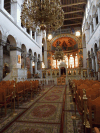

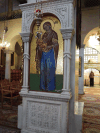
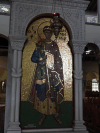


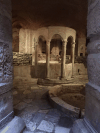

From the Walls of Thessaloniki entry in Wikipedia:
The Walls of Thessaloniki are the city walls surrounding the city of Thessaloniki during the Middle Ages and until the late 19th century, when large parts of the walls, including the entire seaward section, were demolished as part of the Ottoman authorities' restructuring of Thessaloniki's urban fabric. The city was fortified from its establishment in the late 4th century BCE, but the present walls date from the early Byzantine period, ca. 390, and incorporate parts of an earlier, late 3rd-century wall. The walls consist of the typical late Roman mixed construction of ashlar masonry alternating with bands of brick. The northern part of the walls adjoins the acropolis of the city, which formed a separate fortified enceinte, and within it lies another citadel, the Heptapyrgion (Seven Towers), popularly known by the Ottoman translation of the name, Yedi Kule.
The wall is part of the Paleochristian and Byzantine Monuments of Thessalonika, a UNESCO World Heritage Site.





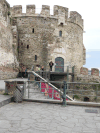



From the Arch of Galerius and Rotunda entry in Wikipedia:
The Rotunda of Galerius, also known (by its consecration and use) as the Greek Orthodox Church of Agios Georgios, and is informally called the Church of the Rotunda (or simply The Rotunda).
The cylindrical structure was built in 306 CE on the orders of the tetrarch Galerius, who was thought to have intended it to be his mausoleum.
The Rotunda has a diameter of 24.5 m (80.4 ft). Its walls are more than 6 m thick, which is why it has withstood Thessaloniki's earthquakes. The walls are interrupted by eight rectangular bays, with the west bay forming the entrance. A flat brick dome, 30 m (100 ft) high at the peak, crowns the cylindrical structure. In its original design, the dome of the Rotunda had an oculus, as does the Pantheon in Rome.
After Galerius's death in 311, he was buried at Felix Romuliana (Gamzigrad) near Zajecar, Serbia. The Rotunda stood empty for several decades until the Emperor Theodosius I ordered its conversion into a Christian church in the late fourth century. The church was embellished with very high quality mosaics. Only fragments have survived of the original decoration, for example, a band depicting saints with hands raised in prayer, in front of complex architectural fantasies.
The building was used as a church (Church of Asomaton or Archangelon) for over 1,200 years until the city fell to the Ottomans. In 1590 it was converted into a mosque, called the Mosque of Suleyman Hortaji Effendi, and a minaret was added to the structure. It was used as a mosque until 1912, when the Greeks captured the city during the Balkan War. Greek Orthodox officials reconsecrated the structure as a church, and they left the minaret. The structure was damaged during an earthquake in 1978 but was subsequently restored. As of 2004, the minaret was still being stabilized with scaffolding. The building is now a historical monument under the Ephorate of Byzantine Antiquities of the Greek Ministry of Culture, although the Greek Orthodox Church has access to the monument for various festivities some days of the year (as Church of Saint George).
The Rotunda is the oldest of Thessaloniki's churches. Some Greek publications claim it is the oldest Christian church in the world, although there are competitors for that title. It is the most important surviving example of a church from the early Christian period of the Greek-speaking part of the Roman Empire.







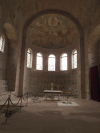






From the Arch of Galerius and Rotunda entry in Wikipedia:
The Arch of Galerius stands on what is now the intersection of Egnatia and Dimitriou Gounari streets. Construction of the arch was spanned the years 298 and 299 CE; it was dedicated in 303 CE to celebrate the victory of the tetrarch Galerius over the Sassanid Persians at the Battle of Satala and the capture of their capital Ctesiphon in 298.
The structure was an octopylon (eight-pillared gateway) forming a triple arch that was built of a rubble masonry core faced first with brick and then with marble panels with sculptural relief. The central arched opening was 9.7 m (31.8 ft) wide and 12.5 m (41.0 ft) high, and the secondary openings on other side were 4.8 m (15.7 ft) wide and 6.5 m (21.3 ft) high. The central arch spanned the portion of the Via Egnatia (primary Roman road from Dyrrhacium to Byzantium) that passed through the city as a decumanus (east-west major street). A road connecting the Rotunda (125 m (410 ft) northeast) with the Palace complex (235 m (771 ft) southwest) passed through the arch along its long axis.
Only the northwestern three of the eight pillars and parts of the masonry cores of the arches above survive: i.e., the entire eastern side (four pillars) and the southernmost one of the western pillars are lost. Extensive consolidation with modern brick has been performed on the exposed masonry cores to protect the monument. The two pillars flanking the central arched passageway retain their sculpted marble slabs, which depict the wars of Galerius against the Persians in broadly panegyric terms.




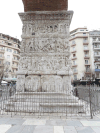






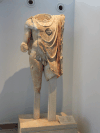
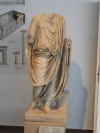
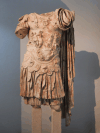


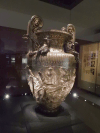
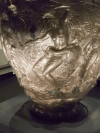
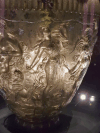
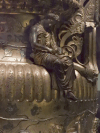
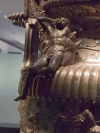
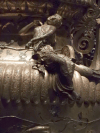
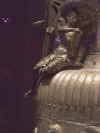



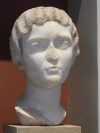
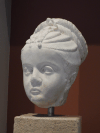
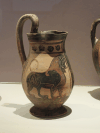
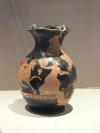

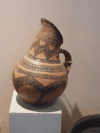
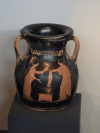


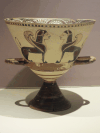



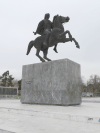

This page contains 80 pictures
Here are the links to the other main pages on Greece:
Page last updated on Fri Aug 26 09:42:52 2022 (Mountain Standard Time)
Page last updated on Fri Apr 26 08:27:44 2024 (Mountain Standard Time)
Thessaloniki on soaring.guenther-eichhorn.com